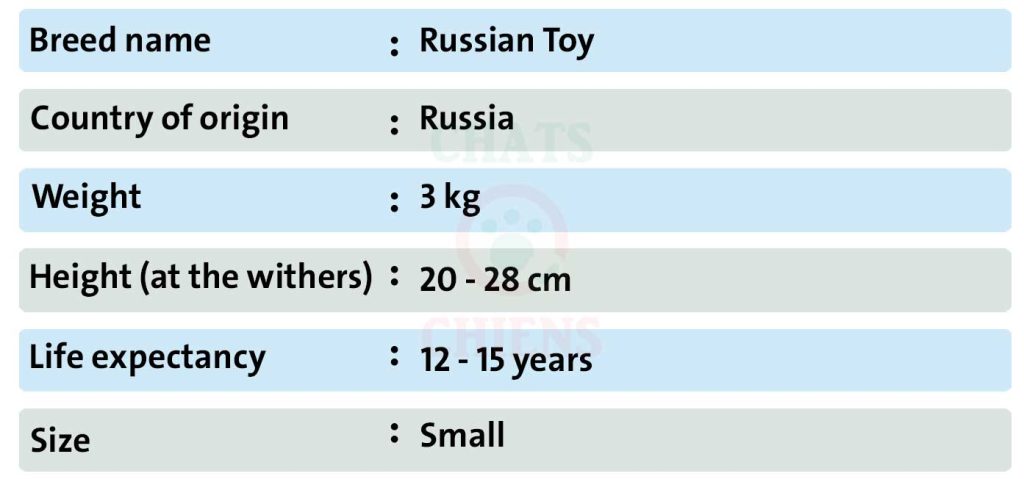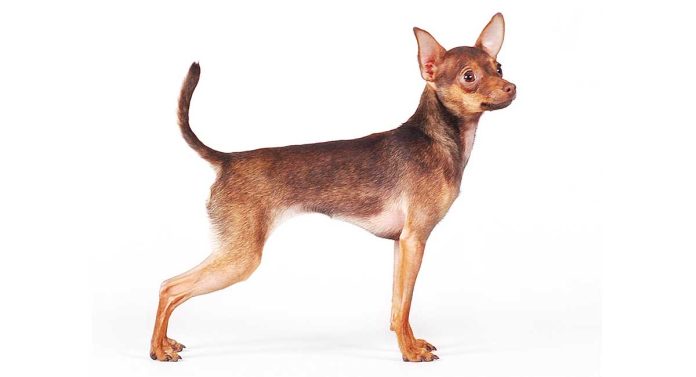Also known as the Russkiy Toy, the Russian Toy is a fragile, graceful, small dog breed that will cause affection in every person. At first glance, this animal looks unhappy, defenseless and even apathetic, but this is until the moment when the dog starts frolicking or gets angry with someone.
The Russian Toy has more than enough energy. A cheerful pet quickly finds a common language with all family members and with all pets. The manner of holding the head, high-set large ears and round eyes with an expressive gaze make Russian toy’s look like cute deer.

Russian Toy photos
[foogallery id=”43825″]
Physical characteristics
The Russian toy is a harmoniously built miniature dog of elegant appearance, resembling miniature toys.
The height at the withers, both in males and in females, is 20 – 28 cm, with a weight of – 3 kg.
There are two varieties in the standard: the short-haired and the long-haired Russian toy. The former are characterized by a smooth, coated and shiny satin coat, while the latter are beautifully feathered on their hind legs and feathered on their ears. The tail is long, carried high, slightly curved.

Distinctive features
- Head: The head is small, round, square in shape, shallow. The muzzle is pointed, the cheekbones are flat. The length of the muzzle is less than the length of the skull.
- Jaws: The jaw is very small, the teeth are small, white as snow. Scissor bite.
- Ears: The ears are relatively large, fine, set high.
- Eyes: The eyes are large and convex, widely spaced, shiny. The color of the iris is always dark.
- Frame: The body is of an ideal graceful build, but very fragile with moderately pronounced musculature. The withers are developed, well marked. Back with a slight inclination towards the croup with a convex loin. The croup is moderately sloping. The abdomen is noticeably upturned.
- Limbs: The legs are straight and parallel, lean, long, representing 65% of the total height of the animal. The legs are oval, compact in size.
- Coat: The coat is short, slightly hard, lying or elongated, regular or wavy, of soft texture, combined with feathering on the tail, ears, legs and neck. The undercoat is missing. The color is black and tan, bluish and tan, chocolate and tan and solid lilac or red.
Character and behavior
The Russian toy is an extremely intelligent, cheerful, playful and independent animal. It is important for him to be constantly on the move, so he does not know how to be sad. However, behind the pretty appearance hides a very difficult character, inherited from the ancestor.
The dog is very devoted to the owner, treats him with adoration and affection, but can also perceive him as personal property. It is on this basis that jealousy is born; the dog is aggressive towards everyone who approaches his object of adoration.
Despite his small size and kindness, he can be mean and selfish, while he is very offended if something doesn’t go his way. Absolutely does not tolerate loneliness, needs the company of people.
With the children
He gets along well with other family members, but he avoids the company of children, because, due to his weak psyche, he reacts extremely painfully to excessively noisy children’s games.
With other animals
Russian toy does not tolerate other pets of any size, especially does not tolerate other dogs.
Health
With proper care, nutrition and maintenance, the Russian Toy can live up to 15 years. At the same time, this decorative doggie practically does not get sick. But it’s not without problems. The weakest and most susceptible to diseases are the bones, heart, teeth, pancreas and skin. The owner of the toy should become familiar with the pet’s predisposition to the following diseases:
- Eye diseases.
- Dislocation of the patella.
- Ear infections.
- Cardiovascular diseases.
Life expectancy
With proper care, nutrition, and maintenance, the Russian toy can live for 12 to 15 years.
Care
Both the long-haired and short-haired varieties require weekly brushing, although the latter require it to a lesser extent. In addition, you need to clean their ears of deposits at least twice a week and do it very carefully, since the cartilage is fragile and sensitive.
Be sure to clean your eyes as needed and trim your fingernails. You can bathe your dog once or twice a month.
Fun facts
- Representatives of the Russian Toy breed are freely admitted to stay in hotels and on public transport. (Russia)
- The Russkiy Toy is an excellent hunter for small burrowing animals. It is not for nothing that in a free translation from Russian the name of the breed is translated – “Russian toy burrowing dog”.
- Long-livers with a maximum life expectancy of about 22 years are known among Russkiy Toy.
History of the breed
Russian toy is a rare breed. They are considered one of the smallest dogs in the world and were developed in Russia in the middle and second half of the 90s. Initially, these dogs were divided into two breeds – short-haired and long-haired. Long-haired specimens appeared much later and also had great popularity. In 1988, the two varieties were merged into one breed.
For the first time, small English terriers were brought to Russia to Emperor Peter I – his dog was called Lisetta, and now his statue is in the Museum of Zoology in St. Petersburg. However, it was the Russian toy, as a separate breed, that was first shown at an exhibition in St. Petersburg in 1874. There are also records of the appearance of 11 people at exhibitions. an exhibition in St. Petersburg in 1907. 1924 was a landmark year for the breed – three dogs received medals at an exhibition in Odessa, and a year earlier they showed themselves at an exhibition in Moscow.
With the advent of the October Revolution, the situation changed dramatically, since the mood of society was directed against the intelligentsia and the aristocracy, and the Russian toy was popular only in these circles. After World War II, in 1947, only one dog was brought to the St. Petersburg exhibition. The lack of population and the low popularity of this breed led breeders to strive to create a slightly larger standard, and by the end of the 1950s the appearance of Russian toys had changed dramatically.
However, the changes were primarily in the size of the animal, and many characteristic external features were retained. The Khrushchev thaw made it possible to take a different look at many things, and the dog again began to gain popularity. In 1960, 76 dogs were shown at the show and the breed standard was approved by the Ministry of Agriculture in 1966. The Fédération Cynologique Internationale finally recognized the breed in 2017.


